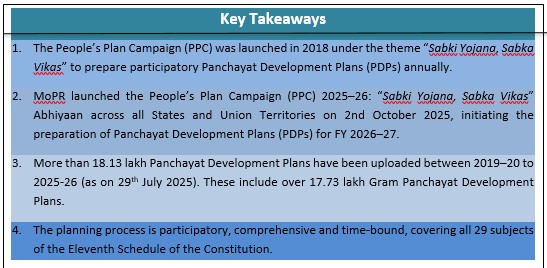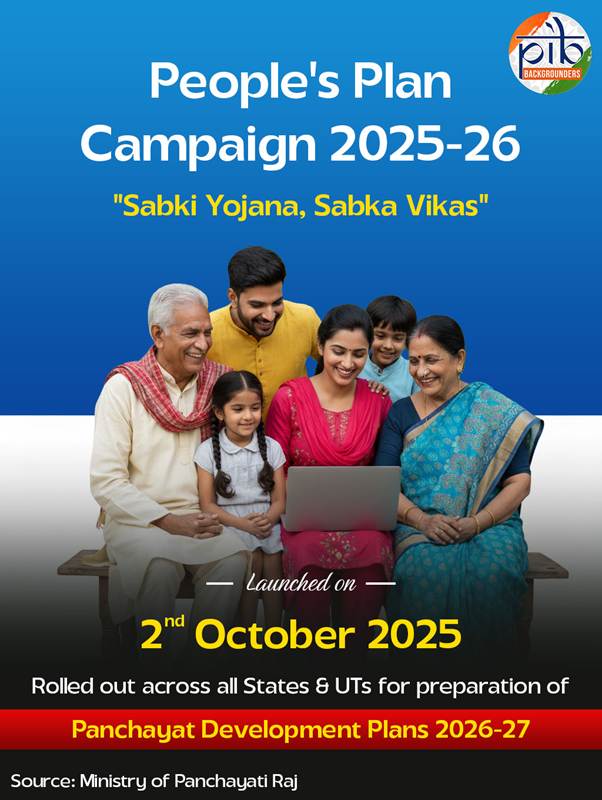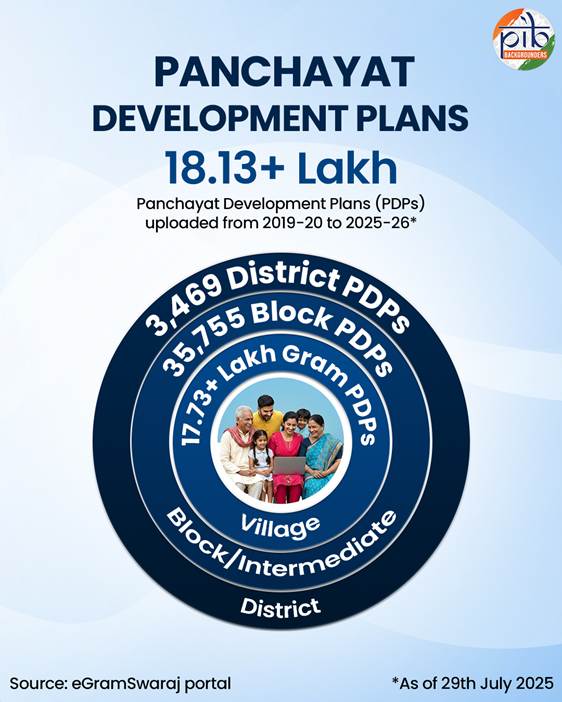PIB Headquarters
People’s Plan Campaign: Strengthening Grassroot Governance, Fostering Inclusive Growth
Viksit Panchayats for Viksit Bharat
Posted On:
05 OCT 2025 5:46PM by PIB Delhi

Introduction & Background
The Gram Panchayat, as the basic unit of the three-tier Panchayati Raj system, holds a central role in rural governance and development. This system was institutionalized through the 73rd Constitutional Amendment Act, 1992, with the objective of strengthening participatory democracy in rural areas. Gram (village) Panchayats not only provide essential services and development at the local level but also play a role in conflict resolution, community meetings, and promoting social well-being.
Development of Panchayats are therefore vital for building a strong foundation for Viksit Bharat.
Article 243G of the Constitution recognizes Panchayats as institutions of local self-government and entrusts them with the preparation of plans for economic development and social justice. Being the closest tier of government to the people, Gram Panchayats are responsible for addressing the needs of marginalized groups and ensuring effective delivery of basic services.
Gram Panchayat Development Plan (GPDP)
Gram Panchayats have been mandated for the preparation of Gram Panchayat Development Plan (GPDP) for economic development and social justice utilizing the resources available to them. The GPDP planning process has to be comprehensive based on participatory process and Panchayats have a significant role to play in the effective and efficient implementation of schemes.
|
A well-structured and inclusive planning process lies at the heart of Panchayat functioning. The Gram Panchayat Development Plan (GPDP) is expected to reflect the needs and priorities of the community, align them with available resources, and be prepared in a fair, transparent and participatory manner.
For effective implementation of schemes on subjects of national importance, Panchayat Development Plans (PDPs) must be comprehensive and participatory. These plans cover the 29 subjects listed in the Eleventh Schedule of the Constitution. While Gram Panchayats prepare GPDPs, Block Panchayats prepare Block Panchayat Development Plans (BPDPs), and District Panchayats prepare District Panchayat Development Plans (DPDPs).
Panchayati Raj Institutions (PRIs) are responsible for delivering services such as water supply, sanitation, roads, drainage, street lighting, health, education, and nutrition at the village level. The 29 subjects of the Eleventh Schedule (To read all the 29 subjects and 73rd Amendment of Panchayati Raj in India, visit @ https://secforuts.mha.gov.in/73rd-amendment-of-panchayati-raj-in-india/) also align closely with the Sustainable Development Goals (SDGs), thus positioning PRIs as key actors in achieving SDGs through localization.
To carry the SDG agenda to the grassroots, the Ministry of Panchayati Raj has adopted a thematic approach, which groups the 17 SDGs into nine broad themes. This approach enables Panchayats to prepare development plans under a ‘whole of government and whole of society’ framework.
Since 2018, Self-Help Groups (SHGs) have also been engaged in preparing Village Prosperity and Resilience Plans (VPRPs), further supporting holistic development and resilience at the village level.
People’s Plan Campaign: Sabki Yojana, Sabka Vikas
To enhance people’s participation in preparing Panchayat Development Plans, the People’s Plan Campaign (PPC) was launched on 2nd October 2018 under the theme “Sabki Yojana, Sabka Vikas”. Encouraged by the positive outcomes of Gram Sabhas, stakeholder engagement, and participatory planning, the Campaign has since been conducted annually in a mission mode with active involvement of Elected Representatives, frontline workers, Self Help Groups (SHGs), Community-Based Organizations (CBOs), and other local stakeholders.
Objective
The People’s Plan Campaign is guided by the objective of preparing participatory, comprehensive and convergent development plans — GPDPs, BPDPs and DPDPs — at Gram Panchayat, Intermediate (Block) Panchayat and District Panchayat levels across the country in a time-bound manner. Structured Gram Sabha meetings are organized with active participation of community members and presentations by frontline workers of all related line departments. The campaign seeks to achieve effective localization of SDGs by integrating the nine thematic approaches of LSDGs into Panchayat Development Plans and by incorporating Village Prosperity and Resilience Plans (VPRPs) prepared by Self-Help Group federations. It also promotes gender-responsive governance through the active involvement of Women Elected Representatives (WERs), SHGs and women community members in the planning process. Further, transparency and accountability are strengthened by conducting public information campaigns and disclosing details of schemes, finances and programmes in Gram Panchayat offices and on public information boards.
People’s Plan Campaign 2025–26
The Ministry of Panchayati Raj launched the People’s Plan Campaign (PPC) 2025–26: “Sabki Yojana, Sabka Vikas” Abhiyaan on 2nd October 2025 across all States and Union Territories, thereby initiating the nationwide process for preparing Panchayat Development Plans (PDPs) for the Financial Year 2026–27.
In the run-up to the launch, extensive preparations were carried out. The Ministry had virtual interactions with State Governments, Union Territories, and State Institutes of Rural Development & Panchayati Raj (SIRD&PRs), to finalize strategies and ensure smooth coordination. To promote convergence and grassroots-level participation, the Ministry is working along with 20 Line Ministries/Departments of the Government of India to direct their respective State/UT counterparts to actively participate in the campaign, particularly through special Gram Sabha meetings. Furthermore, States and UTs has been instructed to appoint nodal officers, train facilitators, finalize schedules for Gram Sabhas, and prominently display Public Information Boards. The Special Gram Sabhas convened on 2nd October 2025 marked the formal launch of the campaign across the country.
The PPC 2025–26 is designed to strengthen participatory, transparent, and accountable local governance. Under this initiative, Gram Sabhas are tasked with reviewing earlier Gram Panchayat Development Plans (GPDPs) using digital platforms such as eGramSwaraj, Meri Panchayat App, and Panchayat NIRNAY. They are expected to assess progress on works, identify delays, and prioritize unfinished projects, especially those linked with unspent Central Finance Commission grants. The planning process will be guided by the Panchayat Advancement Index (PAI), while tools like SabhaSaar will be encouraged to make deliberations more effective. Efforts will also focus on improving Panchayats’ Own Source Revenue (OSR) and ensuring deeper community involvement in decision-making.
A special emphasis of the campaign is on tribal empowerment, with focused activities under the Adi Karmayogi Abhiyaan. By ensuring the active participation of Panchayat representatives, line department officials, community members, Self Help Groups (SHGs), and frontline workers, the campaign aims to further deepen transparency, convergence, and accountability in grassroots planning. It is expected to pave the way for stronger service delivery mechanisms, inclusive development, and improved outcomes for rural communities across India.

Achievement
Since its launch in 2018, the People’s Plan Campaign has helped Panchayats prepare evidence-based and inclusive development plans that reflect local needs while aligning with national priorities.
As per data available on the eGramSwaraj Portal, more than 18.13 lakh Panchayat Development Plans have been uploaded from 2019–20 to 2025-26 (as on 29th July 2025). These include:
- Over 17.73 lakh Gram Panchayat Development Plans (GPDPs)
- 35,755 Block Panchayat Development Plans (BPDPs)
- 3,469 District Panchayat Development Plans (DPDPs)

Conclusion
The People’s Plan Campaign has emerged as a transformative initiative for strengthening grassroots democracy and ensuring inclusive development. By bringing communities, elected representatives and institutions together in preparing Panchayat Development Plans, the Campaign is deepening transparency, convergence and accountability. With active participation of citizens and a strong focus on localization of SDGs, PPC is paving the way for more responsive, empowered and self-reliant Panchayats, contributing to the larger vision of Viksit Bharat.
References:
Click here to see PDF
SK/SM
(Release ID: 2175077)
Visitor Counter : 2335